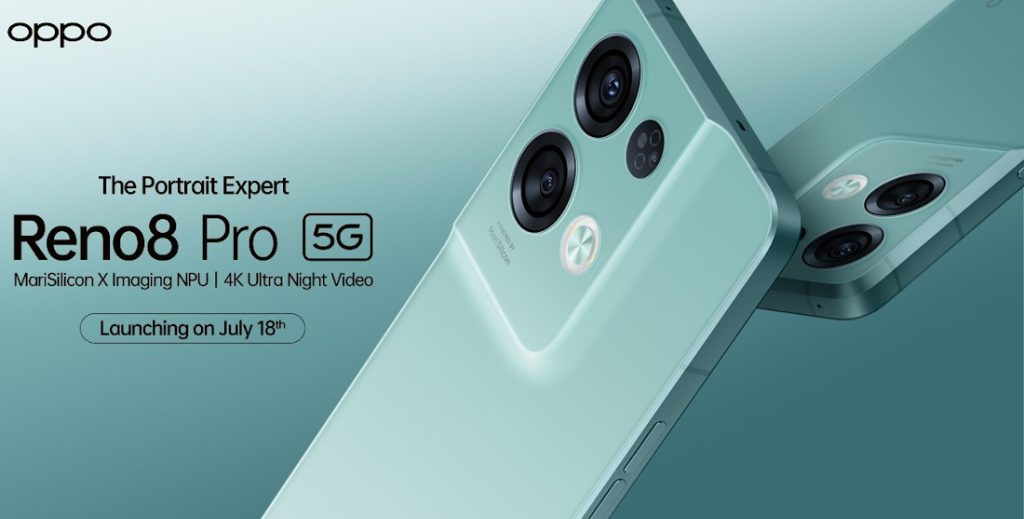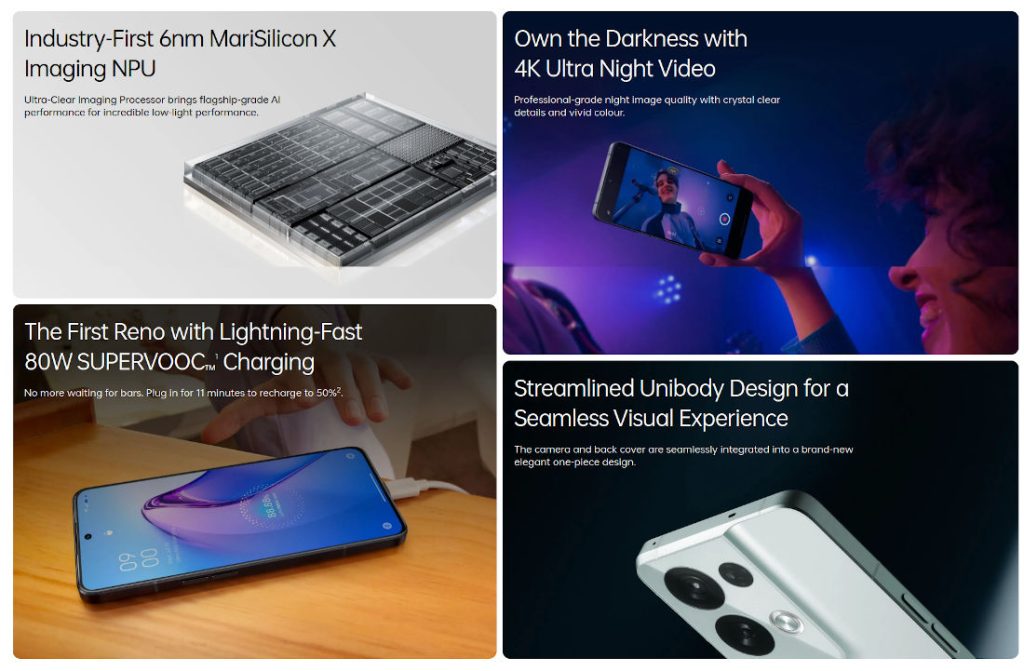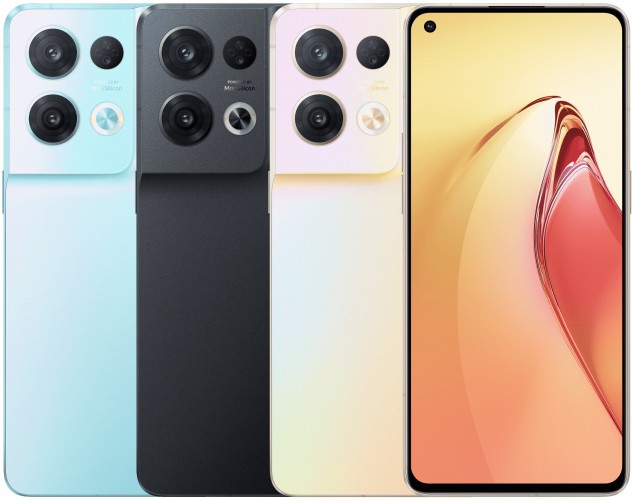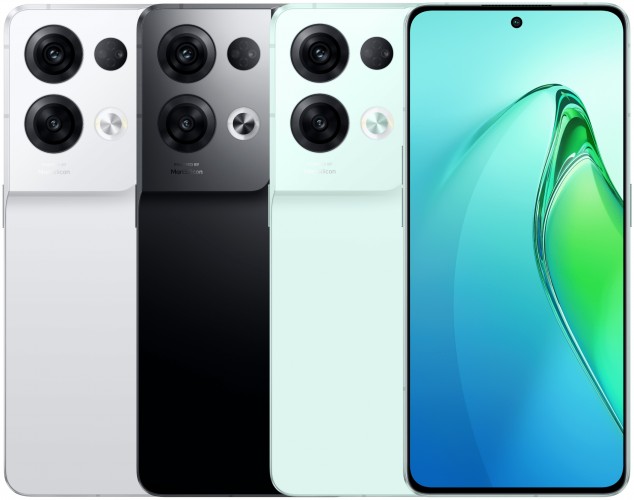
Update: OPPO has confirmed the launch of Rreno8 series in India on July 18th. It said that it has adopted the Golden Ratio from Sacred Geometry as the philosophy for its Reno8 Pro.

For build durability, OPPO said that it has used an aluminium frame, coupled with Gorilla Glass 5. Furthermore, the glass back has been heat-forged and moulded to create an ergonomically streamlined unibody that melds the camera module with the rest of the handset’s back. This new design is the outcome of over a hundred changes and 400+ days of effort.
The ‘Da Vinci’ code
The Golden Ratio (1:.618), which forms the basis of the Reno8 Pro’s design, is a mathematical proportion that is naturally pleasing to the eye. The ancient Greeks observed that it provided for aesthetically pleasing proportions when employed in architecture and art, a notion strengthened during the Renaissance era. The Golden Ratio occurs in the arrangement of the seeds in a sunflower, the petals of a rose, and even the spiral of the Nautilus shell. It is visible in the architecture of the Parthenon, the Great Pyramids and even the Taj Mahal.
Leonardo da Vinci used it as a grid for his Mona Lisa, while Salvador Dalí applied it in The Sacrament of the Last Supper. OPPO said that its designers used this very same proportion to section the rear camera module—both laterally and vertically—on the handset to create a similarly pleasing aesthetic.
The sleekest Reno yet
For ergonomics, OPPO’s engineers observed how users hold their phones to create the streamlined unibody design for the Reno8 Pro. The entire back of the handset uses a single piece of glass that is heat-forged and pressure moulded to form the soft curves required for the camera module.
The process involved creating a graphite mould that was hand polished with three diamond sheets of different roughness to ensure smoothness. To remove the wrinkles caused by high-temperature forging and moulding around the camera module, OPPO employed eight nanometre-scale polishing processes to guarantee a surface fineness of 1-2 nanometres.
As a result, the Reno8 Pro sports a smooth 75-degree micro-arc transition between the camera module and the rest of the back that looks sleek and smooth. It is the slimmest Reno yet and tilts the scales at a mere 183gms.
OPPO follows the same moulded design for the camera module of the OPPO Reno8 to create a classy, premium handset with a streamlined unibody that feels great to hold and use. It weighs a mere 179 grams and is just 7.67mm thin.

Additionally, OPPO’s designers have crafted the camera module to echo the imaging power of the Reno8 Series. In a nod to the classic, the team has designed the prominent binocular camera set-up to resemble the two reels of a film camera. This also draws a parallel to the infinity symbol—as well as the number ‘8’—to denote the smartphone’s comprehensive imaging power and its order in the Reno Series.
At the same time, the adjacent Ring Flash is recognisable and blends perfectly with the lens. Dual flashes have been constructed in a circular shape to create a setup capable of providing adequate fill light when the camera is in use.
The OPPO Reno8 Pro will be available in two colours—Glazed Green and Glazed Black—that showcase its premium quality. The Reno8 will come in two plush hues: Shimmering Gold, a colour effect achieved by a precise combination of dual textures and coatings along with OPPO Glow printing, and Shimmering Black, which is different from pure black as it resembles a starry night sky.
Earlier: After teasers, OPPO today confirmed the launch of Reno8 series that includes the Reno8 and Reno8 Pro smartphones in India in July. The phones were introduced in China in May. The teaser on OPPO India site highlights 6nm MariSilicon X Imaging NPU for the Reno8 Pro. The Ultra-Clear Imaging Processor brings flagship-grade AI performance for incredible low-light performance, says the company.

The 4K Ultra Night Video will offer professional-grade night image quality with crystal clear details and vivid colour, says the company. Even though it is yet to tease other features in India officially and has teasers for feature reveal till July, the company has scheduled the launch of the phone in Malaysia on July 21st.
There the phone has confirmed 80W SuperVOOC charging that can charge the phone up to 50% in 11 minutes, and a streamlined unibody design, so the camera and back cover are seamlessly integrated into a brand-new elegant one-piece design.
![]()
MariSilicon X NPU
OPPO India said that MariSilicon X Neural Processing Unit (NPU) that is designed for computational photography is developed over three years and comprising 400 patent applications—packs 3.6 billion transistors and can perform up to 18 trillion operations per second (18 TOPS). OPPO built MariSilicon X on the cutting-edge 6nm chip architecture that delivers 11.6 TOPS per watt for low-power consumption even in the most demanding tasks.
It is capable of real-time lossless AI processing in the Bayer RAW domain with image data from the 50MP IMX766 rear camera sensor. MariSilicon X’s image processing speed allows users to shoot night videos in 4K Ultra HDR quality with the promise of crystal-clear frames. With the NPU’s support for HDR Fusion and AINR (AI Noise Reduction) algorithm operations, it delivers 4K Ultra Night Video at up to 20Bit (theoretically), with the brightest spot up to 1 million times brighter than the darkest.
OPPO said that it has crafted the Reno8 Series cameras to help photographers and videographers #TransformTheNight by leveraging cutting-edge technologies that tackle the pain points of nighttime shooting, where each frame—movies or stills—is crystal clear and rendered with accurate colours.
PROPRIETARY ALGORITHMS
OPPO added that its engineers have developed algorithms that render accurate Indian skin tones and even create Bokeh Flare Portrait Videos. OPPO’s AI can distinguish between skin blemishes and beauty spots—as well as the age and sex of the subject—to apply different levels of beautification and skin smoothening. OPPO’s cameras recognise shooting scenarios and lighting to select the appropriate camera mode, including HDR for those perfect wide-exposure shots, without user intervention.
RGBW SENSOR TECHNOLOGY
OPPO has partnered with Sony to develop its all-new RGBW (red, green, blue, white) pixel array technology that is an update from traditional RGGB (red, green, green, blue) sensors. This proprietary technology, which involves 87 technical patent applications, inserts W (transparent) pixels in each RGGB pixel to allow 60% more light and a 20.2% increase in purity when compared with regular RGGB sensors.
Essentially, it translates to more detailed low-light captures and improved skin tones in portraits. OPPO and Sony debuted this new RGBW technology in the Reno7 Series with the IMX709 selfie sensor, which continues to drive better light handling and colour tones in OPPO’s portrait photography.

OPPO Reno8 Pro Specifications
- 6.62″ FHD+ (1080 x 2400 pixels) AMOLED, 120Hz display, HDR10+, 1300 nits (peak) brightness
- Build: Glass front (Gorilla Glass 5), aluminum frame
- Octa Core (4 x 2.85GHz A78 + 4 x 2.0GHz A55) Dimensity 8100-Max 5nm processor with Mali-G510 MC6 GPU
- 8GB LPDDR4x RAM with 128GB / 256GB UFS3.1 storage, 12GB LPDDR4x RAM with 256GB UFS3.1 storage
- Android 12, ColorOS 12.1
- Triple camera: 50 MP, IMX766, f/1.8, PDAF; 8 MP, f/2.2, 120˚ (ultrawide); 2 MP, f/2.4, (macro), MariSilicon X NPU
- Front camera: 32 MP, IMX709 sensor, f/2.4, 24mm (wide), 1/2.74″, 0.8µm
- Sensors: Fingerprint (under display, optical), accelerometer, gyro, proximity, compass
- Dimensions: 161 x 74.2 x 7.6 mm; Weight: 188 g
- 5G SA/NSA, Wi-Fi 802.11 ac (2.4GHz / 5GHz), Bluetooth 5.3, USB type C, NFC, USB OTG
- 4500mAh battery with 80W fast charging support

OPPO Reno8 Specifications
- 6.43″ FHD+ (1080 x 2400 pixels) AMOLED, 90Hz display, 800 nits (peak)
- Build: Glass front (Gorilla Glass 5), plastic frame
- MediaTek Dimensity 1300 (6 nm) with Mali-G77 MC9
- 8GB LPDDR4x RAM with 128GB / 256GB UFS3.1 storage, 12GB LPDDR4x RAM with 256GB UFS3.1 storage
- Triple camera: 50 MP, f/1.8, PDAF; 2 MP, f/2.4, (macro); 2 MP, f/2.4, (depth)
- Front camera: 32 MP, f/2.4, 24mm (wide), 1/2.74″, 0.8µm
- Android 12, ColorOS 12.1
- Sensors: Fingerprint (under display, optical), accelerometer, gyro, proximity, compass
- Dimensions: 160.6 x 73.4 x 7.7 mm; Weight: 179 g
- 5G SA/NSA, Wi-Fi 802.11 ac (2.4GHz / 5GHz), Bluetooth 5.3, USB type C, NFC, USB On-The-Go
- 4500mAh battery with 80W fast charging support
We should know all the details, including the launch date, soon.

